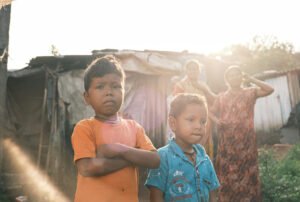
How can frontline communities access public funding for climate solutions? The answers are, well, complex. But some needed elements are clear: these include expertise; values-aligned capacity-building partners; relationships that are built on trust, accountability, and transparency; and flexible funding.
The same elements [needed for] BIPOC communities to benefit from public funding are also the most promising approaches to address…climate change.
We derive these findings from a report we collaborated on, recently published by the National Resources Defense Council, that explored these issues. The report, Connect to Build: Frontline Organization and Federal Infrastructure Funding Opportunities, profiled community groups in many parts of the country, including Memphis, Atlanta, Los Angeles, and the San Francisco Bay Area.
For many community groups, especially in the environmental justice space, funding flowing from the Inflation Reduction Act (IRA), Justice40 commitments, and other federal spending is hard to ignore. But there’s a growing fatigue among environmental and climate justice organizations weighing the cost-benefit of public funding opportunities which often exclude the very communities these funds are supposed to benefit.
Fortunately, some lessons on how to negotiate these tensions are emerging. Not only is it possible to access federal funds, but the same elements that are needed for frontline and underinvested, predominantly BIPOC communities to benefit from public funding are also the most promising approaches to address more broadly the impacts of climate change at the local level. There are also opportunities to advance equity and establish more community-responsive co-governance in the process.
Learning from Community Groups
So, what are we learning? In our report, we examine how frontline groups weigh the pros and cons of taking federal dollars, the ways they’ve been able to use them, and the factors that have enabled them to access public resources. Some leading emerging strategies that we found from across the nation include the following:
- Leveraging philanthropy to ensure community control of public dollars
In Memphis, TN, the Center for Transforming Communities (CTC) cultivates “neighborhood democracies” through place-based organizing. Connie Binkowitz, director of development and external policy at CTC, described how, in 2020, the organization received a grant from the Memphis Division of Housing and Community Development (DHCD). This grant came out of a program supported by federal Community Development Block Grant (CDBG) dollars. Local funds were distributed through DHCD’s Community Coalition Grant Pilot Program. This was followed by a second tranche of dollars in 2023.
Because public dollars often have extensive reporting requirements, CTC feared that accepting these funds might invite financial instability and divert energy from existing programs. CTC, however, was able to draw on flexible funding from a philanthropic partner to reduce this risk. This, in combination with its administrative acumen, strong local networks, and knowledge of community needs, allowed CTC to get public dollars to frontline organizations quickly, benefitting low- and moderate-income neighborhoods throughout Memphis.
- Building local government alliances
In Los Angeles, the Southeast Asian Community Alliance (SEACA) builds power among Southeast Asian youth and their communities to bring about a more just and equitable society through intergenerational, multiethnic dialogue, leadership development, and community organizing. Ten years ago, Executive Director Sissy Trinh, seeing the need for infrastructure, began to advocate for the establishment of a “land bank” as part of the Los Angeles River Master Plan that would allow for the purchase of property for permanently affordable housing. Through this work, SEACA engaged in problem-solving alongside local government decision-makers, demonstrated expertise and building relationships of trust with these officials. These relationships helped position SEACA to secure nearly $50 million in American Rescue Plan Act (ARPA) dollars to fund the land bank, helping prevent displacement and allowing SEACA members and their neighbors to continue to live in communities they had long called home.
Trinh conceded that ARPA allowed local officials an unusual amount of flexibility in rule setting. As a result, local policymakers were eager for SEACA’s input. Yet Trinh contends that even in less favorable situations, relationships with local government matters and can position groups like SEACA to advocate for policies that enable community groups to help direct how funds are spent, such as by setting guidelines for local hiring and procurement.
One area where equity officers can make a difference…is to apply an equity lens to procurement policies and practices.
- Building equity analysis into policy
In Northern California, the Bay Area Regional Health Inequities Initiative (BARHII) has been deeply involved in efforts to integrate equity analysis into policymaking that centers local community partners. This work has occurred across 11 local public health departments and, through Rise Together Bay Area (acquired by BARHII in 2019), in partnership with more than 200 additional organizations.
Melissa Jones, executive director of BARHII, and Deyanira Zavala, managing director for the National Equitable Recovery Alliance at BARHII, explained that in recent years, their organization had encouraged cities to appoint a senior staff person as an equity officer to spearhead government equity efforts. One area where equity officers can make a difference, said Jones, echoing similar advice from Trinh, is to apply an equity lens to procurement policies and practices. For example, Sonoma County established its Office of Equity in 2020. This position became critical a year later when, in December 2021, the county’s Board of Supervisors approved millions of dollars in ARPA funds to support community-led projects and incorporated equity guidelines in the grant process.
The Office of Equity was also central in developing a community-driven process through which proposals were generated. A 15-member ARPA Equity Work Group spent two months identifying deeply embedded barriers to achieving equity with government funds, as well as strategies for overcoming these barriers. It partnered with several other government offices to host five virtual town hall meetings. These public gatherings, along with community surveys, input from the Equity Work Group, and feedback from board members allowed for the identification of 10 community priority areas—including assistance to households’ basic needs, childcare, housing, culturally responsive disaster response, and more. These then became the funding priority areas for the county. Ultimately, community members generated some $172 million worth of potential projects, and received an impressive $39.3 million allocation of funds towards these community priorities.
- Making public funding less burdensome
Pushing for the creation of equity offices and collaborating with these institutions to lead community-driven decision-making processes are not the only available strategies. Changing public funding processes is also critical.
In Chicago, the Center for Neighborhood Technology (CNT) has partnered with the Chicago Metropolitan Agency for Planning (CMAP), the regional planning organization for several counties in northeastern Illinois, to identify changes that can improve the flow of public dollars to frontline organizations. Through this process, the agency is identifying the policies and practices that disadvantage frontline groups and developing alternatives that have the potential to increase the flow of these dollars either to trusted intermediary organizations or directly to frontline groups.
Sign up for our free newsletters
Subscribe to NPQ's newsletters to have our top stories delivered directly to your inbox.
By signing up, you agree to our privacy policy and terms of use, and to receive messages from NPQ and our partners.
Among the barriers identified are insurance, invoicing and reporting requirements (including reimbursement rules), and limited capacity for contract reviews. CNT is working with CMAP to explore how simplified procurement processes, advertising language, streamlined memoranda of understanding, and less complex reporting can make it feasible for groups that are rooted in and trusted by frontline communities to receive federal dollars without also taking on crushing administrative burdens or serious financial and reputational risks.
What Could Make Community-Supportive Practices More Common?
Community groups that were able to leverage public funding succeeded because they had prior experience and relationships with public agencies.
The stories we’ve heard and our own experiences with helping build organizational capacity suggest there are some key elements that can advance community-anchored federal investments and climate outcomes:
1. Investment in regional civic infrastructure
Transformative and permanent capacity building infrastructure is needed. Fortunately, some of this already exists, including foundation-backed, capacity building accelerators; mission-aligned fiscal sponsors that can handle government grant reporting; and some federally funded technical assistance centers. What is missing, however, are long-term administrative resource hubs nationwide, especially in underinvested regions, that can help grassroots organizations navigate the public funding process and advocate on behalf of community groups directly to agencies.
2. Access to flexible dollars for initial spending
Flexible financial support is needed to enable organizations to implement projects while they wait to receive federal dollars or financing. We need more flexible funding options that are accessible to community-led institutions, which might be led by green banks or community development financial institutions (CDFIs). This is critical, especially as the federal Greenhouse Gas Reduction Fund is set to pour billions of dollars into carbon reduction investments starting next year.
3. Local government partnership
Community groups long for transparency in local and state decision-making. They also want to know that public agencies will seriously consider community-driven proposals. What we have observed over the past two years is that the community groups that were able to leverage public funding succeeded because they had prior experience and relationships with public agencies—and the access to information this enables. Obviously, these partnerships need to address power dynamics between city government and community members in a way that honors community expertise. We know too that many city and county governments lack the capacity to develop federal infrastructure projects. So there also needs to be support for government “readiness” to engage in community-driven planning.
4. Space for “right” formations
Another critical step involves helping groups to organize around funding opportunities that align partners in ways that are consistent with their progressive values while ensuring clear roles for implementation that are funded at “right” (that is, sustainable) scale. This runs counter to the reactive response to large federal opportunities, which often leads parties to rush and put together a “winning proposal” that can perpetuate competitiveness and urgency when moving at the speed of trust is needed. This desire for right formation can look like intentional spaciousness for collaborative movement alignment conversations to enable information sharing, strategic partnerships, and effective use of collective resources.
Building Community Power
The bottom line is simple: local climate solutions require community-driven planning processes that build community power.
Naturally, this requires taking all the above conditions into account. Communities must build their community ownership vision and models of climate resilience and green infrastructure. Local governments must be ready to engage communities in bottom-up planning processes.
While seizing the financial opportunity that’s directly before us might be the immediate objective, the long-term goal is more far-reaching. Public funding for transformed and equitable infrastructure is closer than ever, but building community capacity and co-governance models is the real prize at stake.









